Helminths and spirochetes - Study guides, Class notes & Summaries
Looking for the best study guides, study notes and summaries about Helminths and spirochetes? On this page you'll find 62 study documents about Helminths and spirochetes.
Page 2 out of 62 results
Sort by

-
NWHSU Microbiology Midterm Questions and Answers Fully Solved
- Exam (elaborations) • 12 pages • 2024
-
Available in package deal
-
- $19.49
- + learn more
NWHSU Microbiology Midterm Questions and Answers Fully Solved Which are cellular etiologic agents of infectious disease? Bacteria, fungi, protozoa, helminths (worms) Which are a-cellular etiologic agents of infectious disease? Viruses and prions Brainpower Read More Which groups of microorganisms are eukaryotic/prokaryotic? Eukaryotic: fungi, protozoa, helminths (worms) Prokaryotae: bacteria Name major differences between eukaryotic and prokaryotic cells. Eukaryoti...

-
TEST BANK FOR MICROBIOLOGY WITH DISEASES BY TAXONOMY 6TH EDITION ROBERT W. BAUMAN
- Exam (elaborations) • 355 pages • 2023
-
- $21.00
- + learn more
Table of contents 1. A Brief History of Microbiology 2. The Chemistry of Microbiology 3. Cell Structure and Function 4. Microscopy, Staining, and Classification 5. Microbial Metabolism 6. Microbial Nutrition and Growth 7. Microbial Genetics 8. Recombinant DNA Technology 9. Controlling Microbial Growth in the Environment 10. Controlling Microbial Growth in the Body: Antimicrobial Drugs 11. Characterizing and Classifying Prokaryotes 12. Characterizing and Classifying Eukaryotes 13. Ch...
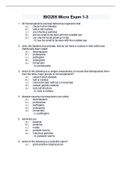
-
BIO205 Micro Exam 1-3
- Exam (elaborations) • 19 pages • 2023
-
- $10.00
- + learn more
1. All microorganisms are best defined as organisms that a.) cause human disease b.) lack a cell nucleus c.) are infectious particles d.) are too small to be seen with the unaided eye e.) can only be found growing in labs - d.) are too small to be seen with the unaided eye 2. cells, like bacteria and archaea, that do not have a nucleus in their cells have traditionally been called a.) decomposers b.) prokaryotes c.) pathogens d.) eukaryotes e.) fermenters - b.) prokaryotes 3...

-
PHLT 304 EXAM 4 Questions & Answers Latest Updated
- Exam (elaborations) • 38 pages • 2023
- Available in package deal
-
- $12.99
- + learn more
Infectious disease: Worms and protozoans, Neglected Tropical diseases - Answers April 4 Neglected Tropical Diseases (NTDs) - Answers A number of NTDs are caused by worms and protozoa • NTDs: substantial morbidity & mortality • typically persist only in the poorest, most marginalized communities and conflict areas • Social stigma & disability • Lost income • Children kept out of school • Reduced ability to care for family • All low-income countries are affected by a...

-
Test Bank for the Human Body in Health & Disease 9th Edition by Patton 2023/2024
- Exam (elaborations) • 442 pages • 2023
-
- $18.99
- + learn more
Test Bank for the Human Body in Health & Disease 9th Edition by Patton d. ammonia to urea for excretion into the urine. ANS: C 61. Ketosis develops in response to a. glycolysis. b. hyperglycemia. c. activation of the urea cycle. d. rapid and incomplete catabolism of fatty acids. ANS: D 62. Which of the following is least related to the aerobic metabolism of glucose? a. Intramitochondrial b. Ketones c. CO 2 + H 2 d. Oxygen ANS: B O + ATP 63. The reaction of –...
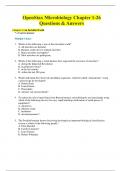
-
OpenStax Microbiology Chapter 1-26 Questions & Answers
- Exam (elaborations) • 330 pages • 2024
-
- $45.00
- + learn more
OpenStax Microbiology Chapter 1-26 Questions & Answers Chapter 1: An Invisible World * = Correct answer Multiple Choice 1. Which of the following is true of the microbial world? A. All microbes are harmful. B. Humans could survive without microbes. C. Many microbes are helpful.* D. Most microbes are pathogenic. 2. Which of the following is when humans first suspected the existence of microbes? A. during the Industrial Revolution B. in prehistoric times* C. in the last century D. ...
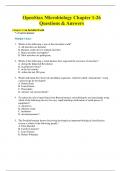
-
OpenStax Microbiology Chapter 1-26 Questions & Answers Chapter 1: An Invisible World * = Correct answer Multiple Choice 1. Which of the following is true of the microbial world? A. All microbes are harmful. B. Humans could survive without microbes. C. Ma
- Exam (elaborations) • 330 pages • 2024
-
- $40.00
- + learn more
OpenStax Microbiology Chapter 1-26 Questions & Answers Chapter 1: An Invisible World * = Correct answer Multiple Choice 1. Which of the following is true of the microbial world? A. All microbes are harmful. B. Humans could survive without microbes. C. Many microbes are helpful.* D. Most microbes are pathogenic. 2. Which of the following is when humans first suspected the existence of microbes? A. during the Industrial Revolution B. in prehistoric times* C. in the last century D. ...
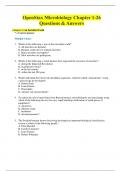
-
OpenStax Microbiology Chapter 1-26 Questions & Answers
- Exam (elaborations) • 330 pages • 2024
-
- $25.99
- + learn more
OpenStax Microbiology Chapter 1-26 Questions & Answers Chapter 1: An Invisible World * = Correct answer Multiple Choice 1. Which of the following is true of the microbial world? A. All microbes are harmful. B. Humans could survive without microbes. C. Many microbes are helpful.* D. Most microbes are pathogenic. 2. Which of the following is when humans first suspected the existence of microbes? A. during the Industrial Revolution B. in prehistoric times* C. in the last century D. ...

-
Microbiology EXAM 1 (Chapters 1,3,4 and 6) Questions With Complete Answers.
- Exam (elaborations) • 17 pages • 2024
-
- $15.00
- + learn more
Microbiology EXAM 1 (Chapters 1,3,4 and 6) Questions With Complete Answers. microobiology The study of organisms too small to be seen with the naked eye is _______ viruses, bacteria, algae, protozoa, fungi and helminths What are the six major groups of microorganisms? 3.5 billion years ago Single celled organisms arose ______ million years ago and have been shaping our earth ever since Eukaryotes = have a true nucleus (include protozoa, fungi, plants and animals) Prokaryotes= lack a tr...
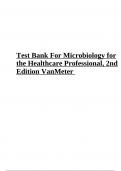
-
Test Bank For Microbiology for the Healthcare Professional, 2nd Edition VanMeter
- Exam (elaborations) • 130 pages • 2023
-
- $35.49
- + learn more
Test Bank For Microbiology for the Healthcare Professional, 2nd Edition VanMeter. Chapter 01: Scope of Microbiology VanMeter: Microbiology for the Healthcare Professional, 2nd EditionChapter 02: Chemistry of Life VanMeter: Microbiology for the Healthcare Professional, 2nd Edition MULTIPLE CHOICE 1. The atomic number equals the number of a. protons. b. neutrons. c. electrons. d. protons and neutrons. ANS: A REF: p. 20 2. The atomic weight is equal to the sum of a. neutrons. b. protons...

$6.50 for your textbook summary multiplied by 100 fellow students... Do the math: that's a lot of money! Don't be a thief of your own wallet and start uploading yours now. Discover all about earning on Stuvia


